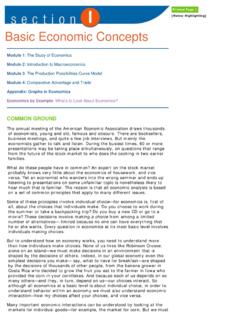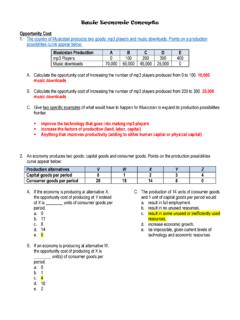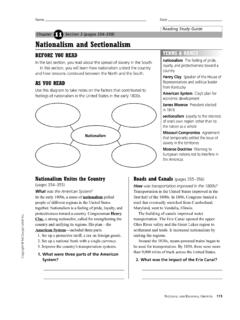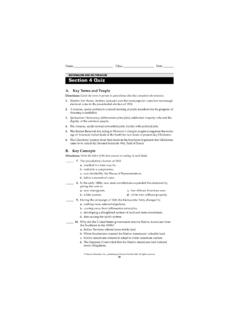Transcription of CHAPTER TELESCOPING THE TIMES Balancing Nationalism …
1 Balancing Nationalism and Sectionalism1 The Americans 1998 McDougal Littell Inc. All rights THE TIMESB alancing Nationalismand SectionalismCHAPTER OVERVIEW American leaders devise a farsighted policy of improve-ments as North, South, and West develop distinct economies; but the sectionsgradually grow to guard their sectional EconomiesCreate DifferencesKEY IDEAAs various sections of the nation develop dif-ferent economic systems, Henry Clay seeks to unify the early 1800s, an Industrial Revolution thathad begun in Britain spread to the United , craft workers made one product at a , business owners achieved mass hired teams of workers who worked in facto-ries powered by water. Using interchangeable parts,the workers produced more products in less timethan with Britain helped spur thesechanges.
2 When the embargo halted American ship-ping, investors put their money into building facto-ries. The New England states pioneered theAmerican industrial age. The first factories weretextile mills, but other industries soon West the old Northwest Territory wasmostly agricultural. Farming was changing, families began to raise livestock and crops forsale, using the cash they earned to buy in the North was free; by 1804, all statesnorth of Delaware had abolished was growing in the South, however. EliWhitney s new invention the cotton gin made itpossible to grow more cotton than before, andBritain s and New England s textile mills demandedmore and more cotton. Southern farmers turnedtheir land into vast cotton fields.
3 As a result, thenumber of slaves nearly doubled. Some AfricanAmericans living in the South were free, but theywere few, and their lives were not much better thanthose of the the sections developed their distincteconomies, leaders looked for ways to unite Madison proposed a plan that HenryClay of Kentucky soon adopted, calling it theAmerican System. The plan called for tariffs on for-eign manufactured goods to allow American indus-try to grow. It included a national bank to establisha national currency. It urged making internalimprovements building federal government never funded theseinternal improvements, but many states did. Somejoined to build the National Road to carry settlerswest. New York built the Erie Canal to connect NewYork City to the Great Lakes.
4 With increased trade,New York City became the country s chief at Center StageKEY IDEAN ationalism exerts a strong influence on thenation s courts, foreign affairs, and westward a series of Supreme Court decisions, ChiefJustice John Marshall promoted the power ofthe federal government. In Gibbons v. Ogden, theCourt ruled that Congress not the states hadthe power over commerce between the states. Secretary of State John Quincy Adams pursueda foreign policy guided by Nationalism . He negoti-ated treaties with Britain that reduced the numberof navy ships on the Great Lakes and settledboundary disputes. In a treaty with Spain, Adamsbrought Florida into the United nations threatened the hemisphere,though. Spain and Portugal seemed ready toreclaim their colonies, which had recently wonindependence.
5 Russia tried to claim more land onthe west coast of North America. President JamesMonroe warned European nations not to interferewith the nations of the Western more and more Americans moved west, newterritories were ready to become states. Theprocess became difficult because of the issue ofslavery. As long as there was an equal number ofslave and free states, both North and South feltcomfortable. When Missouri which allowed slav-ery applied for admission, though, the balancewas threatened. Clay fashioned the MissouriCompromise. This agreement allowed Missouri toenter as a slave state and Maine as a free state. TheCompromise also established that in all territories1 CHAPTER72 The Americans 1998 McDougal Littell rights 2, CHAPTER 7 Summarynorth of 36 30 north latitude, slavery would beillegal except for Age of JacksonKEY IDEAA ndrew Jackson s policies give voice to com-mon people but violate Native American Quincy Adams, who became president afterMonroe, had a difficult term of office.
6 In theelection of 1824, Andrew Jackson had won themost popular votes but lacked the electoral votesto win the presidency. The decision was thrown tothe House of Representatives. Henry Clay whodisliked Jackson personally and politically usedhis influence to give Adams the , Jackson and his followers split to formtheir own party: the Democratic-Republican four years, they attacked Adams, and the coun-try turned toward Jackson. He also won the supportof thousands of Americans recently given the voteby more liberal election laws. Jackson won the 1828election by a wide in office, Jackson removed about 10 per-cent of federal workers from office. He replacedthem with new workers loyal to the demand for farmland grew, settlers againlooked on the lands of Native Americans in theSouth and West.
7 Jackson decided to move theNative Americans elsewhere. Congress passed theIndian Removal Act in 1830. The Cherokee Nationfought back in the courts. When Chief JusticeMarshall ruled in their favor, Jackson refused tocomply. Instead, federal agents signed a treaty witha group of Cherokee leaders willing to leave. In1838, the army forced the remaining 20,000 Cherokee to march west. The Cherokee called thejourney Trail of Tears because it caused the deathof more than a quarter of their , States Rights,and the National BankKEY IDEAA ndrew Jackson deals with states rights andthe Bank of the United Tariff of 1816 (raised twice by 1828)increased the price of foreign manufacturedgoods. Although he had supported the tariff before,John C.
8 Calhoun of South Carolina came to opposeit bitterly. Southerners, with little industry of theirown, felt that they were paying to build industry inthe North. Calhoun argued that states could nulli-fy or declare void any federal law that theyopposed. The Senate debated the tariff in 1830. ASouth Carolina Senator blasted the tariff as a threatto the South and to states rights. MassachusettsSenator Daniel Webster made an impassionedargument that the Union was created by the peo-ple, not the years later, the issue came to a passed a new tariff, and the SouthCarolina legislature declared it invalid. PresidentJackson threatened to send troops to make SouthCarolina obey the law. Clay suggested lowering thetariff over time .
9 The compromise was accepted,and tempers faced another conflict arising from hisopposition to the Bank of the United States. Hethought the bank a threat to democracy, calling it the monster. He tried to shut the bank down bywithdrawing the Treasury s money. When the bank spresident called for all loans to be repaid, a panicresulted, and the bank lost its remaining 1836, the bank s charter expired. After the col-lapse of the bank, New York City became thenation s financial capital. Jackson s attacks on thebank angered Clay, Webster, and others, whoformed a new party: the two terms, Jackson retired, but his vice-president, Martin Van Buren, won election. Heinherited a financial mess brought on by the fightover the bank.
10 Unable to fix the country s economy,Van Buren lost the 1840 election to Whig candidateWilliam Henry Harrison. Harrison died soon aftertaking office, however, and John Tyler succeededhim as president. Because Tyler agreed with fewWhig positions, the party could not enact its pro-gram into Jackson years had radically changed poli-tics. Candidates had to campaign hard for officeand tried to win wide popular support. The averagecitizen was more politically aware and had morepolitical power than ever before. 34















